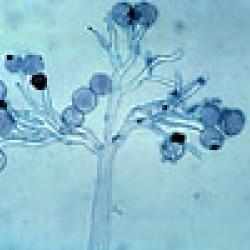Source Institutions
Source Institutions
Add to list Go to activity
Activity link broken? See if it's at the internet archive

In this laboratory activity, learners use a simple procedure to bait oomycetes from water and/ or soil and then examine these fungus-like organisms with the microscope to see how they look. They will see large hyphae, sporangia and swimming asexual spores (zoospores), the structures involved in sexual reproduction (oogonia and antheridia), and how the shapes and sizes of these structures may vary among different kinds of oomycetes. Learners may then design their own biodiversity experiments to see if the use of different natural water sources, different kinds of soils, or different baits affect the variety of oomycetes baited. Please scroll down for activity component links.
- 1 to 2 hours
- 1 to 7 days
- $1 - $5 per group of students
- Ages 11 - 18
- Activity, Demonstration, Experiment/Lab Activity, Lesson/Lesson Plan
- English
Quick Guide
Materials List (per group of students)
- small jars with lids
- small glass or clear plastic dishes
- microscope slides, coverslips
- forceps, probes
- compound microscope, binocular dissecting microscope
- whole or cut fruit such as apple or pear
- popped popcorn kernels (no butter or salt!)
- sesame seeds
- dead insects (flies, ants, etc.)
- spider web (would on a toothpick)
- insect wings
- pollen
- thin pieces of plant tissue like onion skin, grass blades, etc.
- water from a relatively clean, natural water source
- boiled and cooled distilled water for baiting from soils
- Natural soils
Subjects
-
Life Sciences
-
Cells
- Cell Structure and Function
- Cell Division
-
Diversity of Life
- Protists and Fungi
- Classification
- Ecology
-
Cells
-
The Nature of Science
-
The Scientific Process
- Conducting Investigations
-
The Scientific Process
Informal Categories
- Nature and Environment
Audience
To use this activity, learners need to:
- see
- see color
- touch
Learning styles supported:
- Involves hands-on or lab activities
Other
Components that are part of this resource:
- Purpose and Background Information
- Materials and Methods
- Lesson Plan
- Supplemental Information and References
- Diagrams
This resource is part of:
Access Rights:
- Free access
By:
- Schumann, Gail L. ; Jasalavich, Claudia A.
Rights:
- All rights reserved, The American Phytopathological Society, 2011
